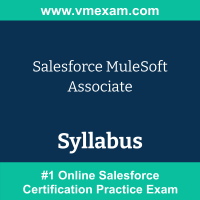 The Salesforce MuleSoft Associate exam preparation guide is designed to provide candidates with necessary information about the MuleSoft Associate exam. It includes exam summary, sample questions, practice test, objectives and ways to interpret the exam objectives to enable candidates to assess the types of questions-answers that may be asked during the Salesforce Certified MuleSoft Associate exam.
The Salesforce MuleSoft Associate exam preparation guide is designed to provide candidates with necessary information about the MuleSoft Associate exam. It includes exam summary, sample questions, practice test, objectives and ways to interpret the exam objectives to enable candidates to assess the types of questions-answers that may be asked during the Salesforce Certified MuleSoft Associate exam.
It is recommended for all the candidates to refer the MuleSoft Associate objectives and sample questions provided in this preparation guide. The Salesforce MuleSoft Associate certification is mainly targeted to the candidates who want to build their career in Salesforce Associate domain and demonstrate their expertise. We suggest you to use practice exam listed in this cert guide to get used to with exam environment and identify the knowledge areas where you need more work prior to taking the actual Salesforce MuleSoft Associate exam.
Salesforce MuleSoft Associate Exam Summary:
|
Exam Name
|
Salesforce MuleSoft Associate |
| Exam Code | MuleSoft Associate |
| Exam Price |
Registration fee: USD 75 Retake fee: Free |
| Duration | 70 minutes |
| Number of Questions | 40 |
| Passing Score | 70% |
| Recommended Training / Books | Prepare for Your Salesforce MuleSoft Associate Credential |
| Schedule Exam | Kryterion Webassessor |
| Sample Questions | Salesforce MuleSoft Associate Sample Questions |
| Recommended Practice | Salesforce Certified MuleSoft Associate Practice Test |
Salesforce MuleSoft Associate Syllabus:
| Section | Objectives | Weight |
|---|---|---|
| Identify the roles, responsibilities, and lifecycle of a integration project |
- Identify the common reasons that IT integration projects frequently fail. - Define the IT delivery gap and describe MuleSoft's approach to closing it. - Describe the characteristics and roles of an API-led IT delivery model that emphasizes both production and consumption. - Describe the common delivery methodologies for integration projects. - Identify key DevOps practices and tools for building, testing, deploying, and delivering integration solutions. - Identify and describe the steps of the design, implement, and management stages of MuleSoft's recommended product-centric API lifecycle. - Describe the roles and responsibilities within a typical MuleSoft integration project team. |
17% |
| Recognize and interpret essential integration concepts and terminology |
- Distinguish between Infrastructure as a Service (IaaS), Platform as a Service (PaaS), and Software as a Service (SaaS). - Identify the types of virtualization, computing, and storage infrastructure required by enterprise systems and describe the principles of system scalability. - Classify and describe common networking protocols used in system communication. - Recognize the differences between common data formats (for example, XML, YAML, and JSON) used in transformations and configuration files. - Define and describe the core concepts of API and enterprise system security. - Identify and describe the HTTP components that enable RESTful web services. - Define and correctly use the terms API implementation, API proxy, API interface, API client/consumer, and API invocation. - Identify and classify RESTful, SOAP, AsyncAPI, and GraphQL APIs. |
20% |
| Recognize common integration problems, use cases, and technical solutions |
- Classify and describe the characteristics of common enterprise systems. - Classify and describe the tradeoffs of legacy and modern integration approaches. - Given a complex business problem, identify the fundamental integration use cases that can deliver an end-to-end business solution. - Describe the purpose and function of the different classes of integration technologies. - Identify the types of integration technologies that are most suitable to realize different integration use cases and business scenarios. - Deconstruct an integration solution into its integration system constituents. |
17% |
| Explain the common technical complexities and patterns in integration development |
- Describe the differences between the request-reply, one-way, multicast, batch, and stream interaction patterns. - Explain the differences between the aggregation, orchestration, and choreography composition patterns. - Describe the purpose of an API specification and the benefits of following a design-first approach to API development. - Describe and compare observability approaches for integration solutions including logs, metrics, and tracing. - Design MuleSoft applications using common features of core connectors. - Describe the differences between cloud, hybrid, and on-premise deployment architectures. - Describe the differences and tradeoffs between monolithic and microservices application architectures. - Describe the difference between a service mesh and an API gateway. |
18% |
| Describe the components and benefits of Anypoint Platform for system integration |
- Identify the primary components of Anypoint Platform and their benefits for system integration. - Identify and describe the common characteristics of popular Anypoint Connectors for connecting to software applications, databases, and protocols. - Identify the components and describe the benefits of the Anypoint Platform runtime planes and control planes. - Describe the MuleSoft-hosted and customer-hosted deployment options for Anypoint Platform. - Describe the uses and benefits of the Anypoint Platform development tools and languages for integration developers and DevOps teams. - Describe and classify the types of reusable assets in Anypoint Exchange that form the building blocks of integration solutions. |
18% |
| Describe the components and benefits of Anypoint Platform for API management |
- Identify the primary components of Anypoint Platform and their benefits for API management. - Identify how MuleSoft products realize the goals of full lifecycle API development and Universal API Management (UAPIM). - Explain the advantages of API-led connectivity with Anypoint Platform over other integration and API management approaches. |
10% |
